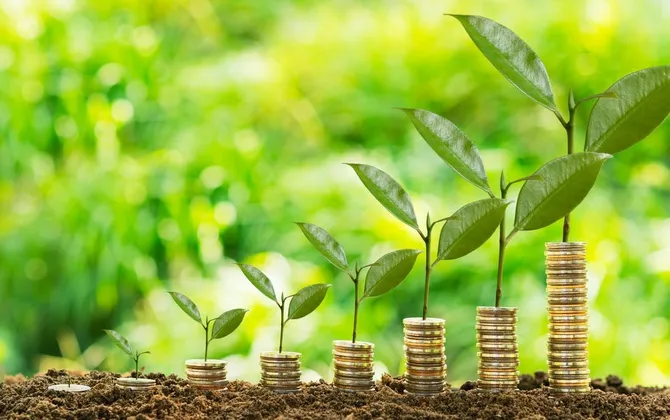
The textile industry serves as a poignant illustration, wherein numerous enterprises struggle to secure orders due to their failure to meet "green" standards. Yet, navigating this transition is fraught with challenges."
It's Green or Bust
Dr. Nguyễn Hoa Cương, Deputy Director of the Central Institute for Economic Management Research, emphasizes the paramount importance and widespread attention garnered by the concept of "green." To underscore this, he draws a comparison: while searching the internet for keywords related to prevailing economic or political phenomena such as "economic recession" or "Russia-Ukraine" yields 220 million and 238 million results respectively, queries for "green economy" and "green finance" yield a staggering 1.7 billion and 2.1 billion results. This signifies a tenfold higher level of interest in green economy and finance compared to the hottest economic and political issues. Similarly, within Vietnam, searches in Vietnamese for "economic recession" yield 11 million results, whereas "green economy" and "green finance" amass over 140 million and 410 million results respectively.
Dr. Cấn Văn Lực, a member of the National Financial and Monetary Policy Advisory Council, provides five compelling reasons for embracing green growth: 1. Health-Environment Linkage: The environment and health share an intimate connection, making sustainable environmental practices crucial for public health. 2. Climate Change Vulnerability: Vietnam ranks among the five nations most profoundly impacted by climate change, with potential GDP losses projected to reach 11% by 2100. Mitigating these effects necessitates a shift towards green growth strategies. 3. Economic Efficiency and Job Creation: Investment in green growth yields superior returns compared to conventional approaches. Not only does it enhance economic efficiency, but it also fosters environmental and social benefits while generating employment opportunities. For every USD 1 million invested in green growth, a minimum of 5 jobs is created, surpassing the job creation potential of traditional investments. 4. Enhanced Competitiveness: Prioritizing green growth elevates national competitiveness, enhances appeal to foreign investors, and bolsters competitiveness in export markets. 5. Economic and Business Resilience: Embracing green growth fortifies the resilience of the economy and businesses, enabling them to weather environmental and economic shocks more effectively.
Dr. Bùi Quang Tuấn, former Director of the Vietnam Institute of Economics, asserts that while Vietnam may lag behind in overall development compared to global and regional benchmarks, the nation is aligned with international trends in embracing green growth philosophies. Vietnam's commitment to green growth was established early on, yet progress remains at an early stage. While significant strides have been made in formulating numerous strategies, master plans, and initiatives for green transformation, the bulk of the work—approximately three-quarters—pertains to implementation. Presently, progress in this regard remains limited, with challenges persisting in transitioning from planning to action.
Urgency of Green Classification in Vietnam's Growth Agenda
The urgency of establishing a green classification system is underscored by the substantial resources required for Vietnam to achieve its green growth objectives. According to estimates from the Asian Development Bank (ADB), approximately USD 368 billion is needed for the period up to 2040, equivalent to an annual expenditure of USD 20 billion. Similarly, the capital required to implement the National Green Growth Strategy for the 2021-2030 period is substantial, with the Ministry of Planning and Investment estimating around USD 872 billion, based on specific economic assumptions until 2050.
Despite early encouragement of green transformation initiatives, Vietnam has encountered challenges in effectively channeling financial resources towards sustainable endeavors. Ms. Phạm Thị Thanh Tùng, Deputy Director of the Credit Department for Economic Sectors at the State Bank, highlights that while numerous mechanisms and policies have been introduced over the past seven years (2017-2023), the balance of green credit has seen an average annual growth rate exceeding 22%. However, green credit comprises only 4.5% of the total debt balance. One significant factor contributing to this disparity is the absence of a unified green classification system.
Dr. Cấn Văn Lực observes that the uptake of green bonds remains notably modest. Over the period of 2016-2020, there were only four green bond issuances, totaling USD 284 million. Subsequently, from 2019-2023, approximately USD 1.16 billion worth of green bonds were issued. Conversely, the market for green stocks is virtually non-existent. This situation is attributed to the absence of detailed instructions, criteria, and a green classification list. Consequently, even with foreign support capital available, it cannot be effectively utilized.
Moreover, beyond the primary obstacle posed by the lack of green criteria and a classification list, there exists a notable deficiency in strong motivation, as well as ambiguity regarding the role and responsibilities of the State. According to Dr. Bùi Quang Tuấn, the imperative for green transformation is imminent, yet the level of attention and focus remains inadequate. Achieving this transition necessitates the replacement of costly technology systems, thus requiring preferential interest rates, enticing financial instruments, and clear State support and intervention in the market. The absence of such support risks constraining market supply. Unfortunately, this critical issue has not received the requisite attention it deserves.
Associate Professor Dr. Trần Đình Thiên, former Director of the Vietnam Institute of Economics, emphasizes the need for the State to assume specific responsibilities beyond merely providing a legal framework. He contends that while the market will inevitably penalize non-green businesses in the future, there must be a clear and harmonized alignment of national interests and corporate obligations.
Echoing this sentiment, Dr. Cấn Văn Lực underscores the importance of employing both "sticks" and "carrots" to engender strong motivation for green transformation. Merely issuing policy mechanisms without active involvement and support from the State risks impeding the success of businesses.
Dr. Cấn Văn Lực further highlights the untapped potential of international investment funds, amounting to USD 15.5 billion, available for investment in Vietnam. However, to access this capital, specific green lists, projects, and programs are required. The absence of such a "green" list impedes Vietnam's ability to attract and utilize these funds effectively.




















